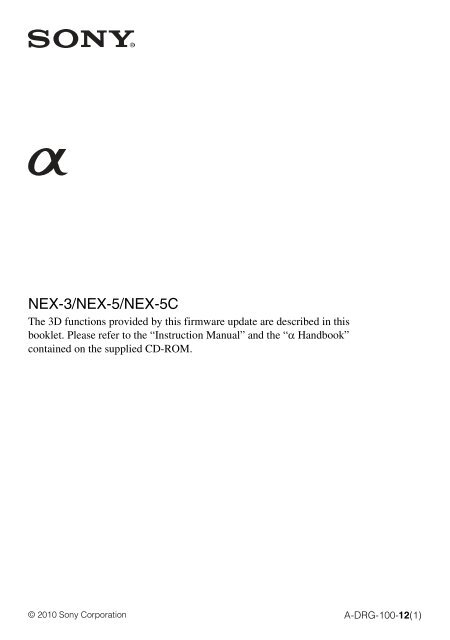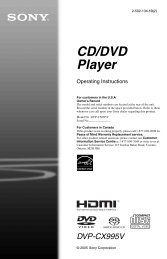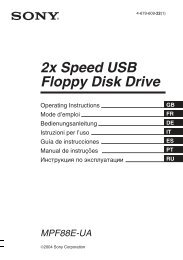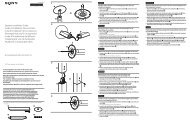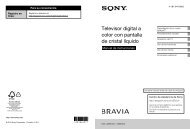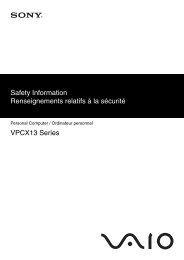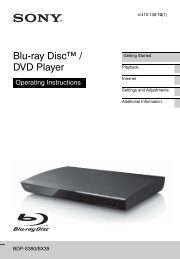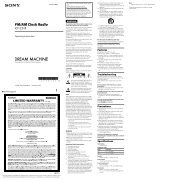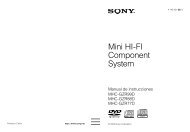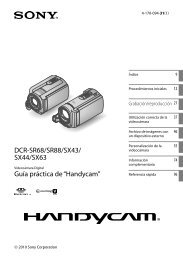Create successful ePaper yourself
Turn your PDF publications into a flip-book with our unique Google optimized e-Paper software.
<strong>NEX</strong>-3/<strong>NEX</strong>-5/<strong>NEX</strong>-<strong>5C</strong><br />
The 3D functions provided by this firmware update are described in this<br />
booklet. Please refer to the “Instruction Manual” and the “α Handbook”<br />
contained on the supplied CD-ROM.<br />
© 2010 <strong>Sony</strong> Corporation<br />
A-DRG-100-12(1)
3D Functions<br />
3D images shot in [3D Sweep Panorama] mode of this camera can be played back only<br />
on a 3D TV. The recorded images are played back as normal still images on the LCD<br />
monitor of this camera and a non-3D TV.<br />
Shooting<br />
To shoot 3D images, sweep the camera as<br />
illustrated.<br />
Viewing<br />
Connect the camera to a 3D TV using an HDMI<br />
cable (sold separately) (page 9).<br />
z File name of the 3D image<br />
Note<br />
1 To the HDMI<br />
connector<br />
HDMI cable<br />
2 To the HDMI<br />
terminal<br />
A 3D image consists of both JPEG and MPO files.<br />
If you import images shot in [3D Sweep Panorama] mode into a computer, the following<br />
two image data are stored in the same folder on the computer.<br />
DSC0sss.jpg<br />
DSC0sss.mpo<br />
If you delete either the JPEG file or the MPO file comprising a 3D image, that 3D image<br />
may not be played back.<br />
You may feel uncomfortable symptoms such as eyestrain, nausea, or a tired feeling while watching 3D<br />
images recorded with the camera on 3D compatible monitors. When you watch 3D images, we<br />
recommend that you take a break at regular time intervals. Since the need for or frequency of break times<br />
varies between individuals, please set your own standards. If you feel sick, stop watching 3D images, and<br />
consult a doctor as needed. Also, refer to the operating instructions of the connected device or the<br />
software used with the camera. A child’s vision is always vulnerable (especially for children under six<br />
years of age). Before allowing them to watch 3D images, please consult with an expert, such as a<br />
pediatric or ophthalmic doctor. Make sure your children follow the precautions above.<br />
2 GB
3D functions provided<br />
New functions are provided to the menu by this firmware update.<br />
Menu New items provided Functions<br />
Shoot Mode 3D Sweep Panorama Sets 3D image shooting.<br />
Camera 3D Panorama Direct. Sets the shooting direction for 3D<br />
images.<br />
Image Size 3D Panorama: Image Size Selects the size of 3D images.<br />
Playback Slide Show t Image Type Automatically plays back 3D images<br />
only on a 3D TV connected to the<br />
camera.<br />
Playback 3D Viewing Plays back 3D images on a 3D TV<br />
connected to the camera.<br />
3 GB
3D Sweep Panorama<br />
Allows you to create a 3D image from composed images.<br />
1 [Menu] t [Shoot Mode] t [3D Sweep Panorama].<br />
2 Point the camera at the edge of the subject,<br />
then press the shutter button fully down.<br />
3 Pan the camera to the end, following the<br />
guidance on the LCD monitor.<br />
Notes<br />
This part will not be taken.<br />
Guidance bar<br />
If you cannot pan the camera across the entire subject within the given time, a gray area occurs in the<br />
composed image. We recommend you pan the camera 180 degrees within about six seconds when using<br />
an E18 – 55 mm lens at the wide end (18 mm) for better results. You should pan the camera slower with<br />
the telephoto side of the lens.<br />
If you shoot a 3D image with T side of a zoom lens, a gray area may occur more often, or shooting may<br />
be stopped. It is recommended to use a zoom lens with W side.<br />
The camera continues shooting during [3D Sweep Panorama] recording, and the shutter keeps clicking<br />
until the end of the shooting.<br />
Since several images are stitched together, the stitched part will not be recorded smoothly.<br />
Under low light conditions, 3D panoramic images may be blurred.<br />
Under lights that flicker such as fluorescent light, the brightness or color of the combined image is not<br />
always the same.<br />
When the whole angle of 3D panoramic shooting and the angle in which you fixed the focus and exposure<br />
(AE/AF lock) by pressing the shutter button halfway down are extremely different in brightness, color<br />
and focus, the shooting will not be successful. If this happens, change the lock angle and shoot again.<br />
[3D Sweep Panorama] is not suitable when shooting:<br />
– Subjects are moving.<br />
– Subjects are too close to the camera.<br />
– Subjects with a repeating pattern such as tiles, and subjects with little contrast such as sky, sandy<br />
beach, or lawn.<br />
– Subjects with constant change such as waves or water falls.<br />
– Subjects with the sun or electric lights, etc. that are much brighter than surroundings.<br />
[3D Sweep Panorama] recording may be discontinued in the following situations:<br />
– You pan the camera too fast or too slow.<br />
– There is too much camera shake.<br />
A 3D image consists of both JPEG and MPO files. If you delete either the JPEG file or the MPO file<br />
comprising a 3D image, that 3D image may not be played back.<br />
You can pan the camera in the horizontal direction only when shooting 3D Sweep Panorama images.<br />
Continued r<br />
4 GB
z Tips for shooting a 3D image<br />
Shoot a still subject.<br />
Maintain a sufficient distance between the subject and the<br />
background.<br />
Shoot 3D images in a bright place, such as outdoors.<br />
Determine the scene and press the shutter button halfway,<br />
so that you can lock the focus, exposure, and white balance.<br />
Then, press the shutter button fully down and pan the<br />
camera.<br />
When using a zoom lens, it is recommended to use it with<br />
W side.<br />
Pan the camera in an arc at a constant speed in<br />
the direction indicated on the LCD screen,<br />
taking the following points into account. You<br />
should pan at about half speed of that in<br />
normal sweep panorama shooting.<br />
5 GB
3D Panorama Direct.<br />
Sets the direction to pan the camera when you shoot 3D Sweep Panorama images.<br />
1 [Menu] t [Camera] t [3D Panorama Direct.] t desired mode.<br />
(Right) Pan the camera from the left to the right.<br />
(Left) Pan the camera from the right to the left.<br />
6 GB
Image Size<br />
Sets the image size to shoot 3D Sweep Panorama images.<br />
1 [Menu] t [Image Size] t [3D Panorama: Image Size] t desired mode.<br />
(Standard)<br />
(Wide)<br />
(16:9) Horizontal: 1920 × 1080<br />
Horizontal: 4912 × 1080<br />
Horizontal: 7152 × 1080<br />
z Tips for selecting the image size<br />
The 3D images appear differently, depending on the mode selected.<br />
16:9 Standard Wide<br />
When [Standard] or [Wide] is selected, the images are scrolled when you press the center of<br />
the control wheel.<br />
7 GB
Image Type<br />
Plays back only 3D images in Slide Show on the 3D TV connected to the camera.<br />
1 [Menu] t [Playback] t [Slide Show] t [Image Type] t desired mode.<br />
All Plays back all still images on the memory card as normal<br />
images.<br />
Display 3D Only Plays back 3D images only.<br />
8 GB
3D Viewing<br />
To view 3D panorama images recorded on the camera on a 3D TV, set as follows.<br />
Connect the camera to a 3D TV using an HDMI cable (sold separately).<br />
1 Connect the camera to the 3D TV using an<br />
HDMI cable (sold separately).<br />
2 [Menu] t [Playback] t [3D Viewing] t<br />
[OK].<br />
3D panorama images shot with the camera appear on the<br />
TV screen.<br />
When [Standard] or [Wide] is selected, you can scroll<br />
3D panorama images by pressing the center of the<br />
control wheel.<br />
Notes<br />
When you select [3D Viewing] mode, only 3D images are displayed.<br />
Do not connect the camera and equipment to be connected using output terminals. When the camera and<br />
TV are connected using output terminals, no video and sound are produced. Such connection can also<br />
cause trouble of the camera and/or connected equipment.<br />
This function may not work properly with some TVs. For example, you may not be able to view a video<br />
on your TV, output in 3D mode or hear sound from the TV.<br />
Use an HDMI cable with the HDMI logo.<br />
Use an HDMI mini connector on one end (for the camera), and a plug suitable for connecting your TV on<br />
the other end.<br />
Influenced by the signal output from the TV to 3D glasses, the RMT-DSLR1 Wireless Remote<br />
Commander (sold separately) may not operate correctly. When using the Wireless Remote Commander,<br />
place the camera as far away from the TV as possible with the camera's remote sensor facing away from<br />
the TV. (<strong>NEX</strong>-5/<strong>5C</strong> only)<br />
z To view normal still images on a TV<br />
1 To the HDMI<br />
connector<br />
HDMI cable<br />
2 To the HDMI<br />
terminal<br />
If you select [3D Viewing], only 3D images are displayed on the TV.<br />
To view normal still images, press the bottom of the control wheel to finish [3D Viewing].<br />
To return to 3D, press the bottom of the control wheel again.<br />
To display the image index, select [Menu] t [Playback] t [Image Index].<br />
9 GB


